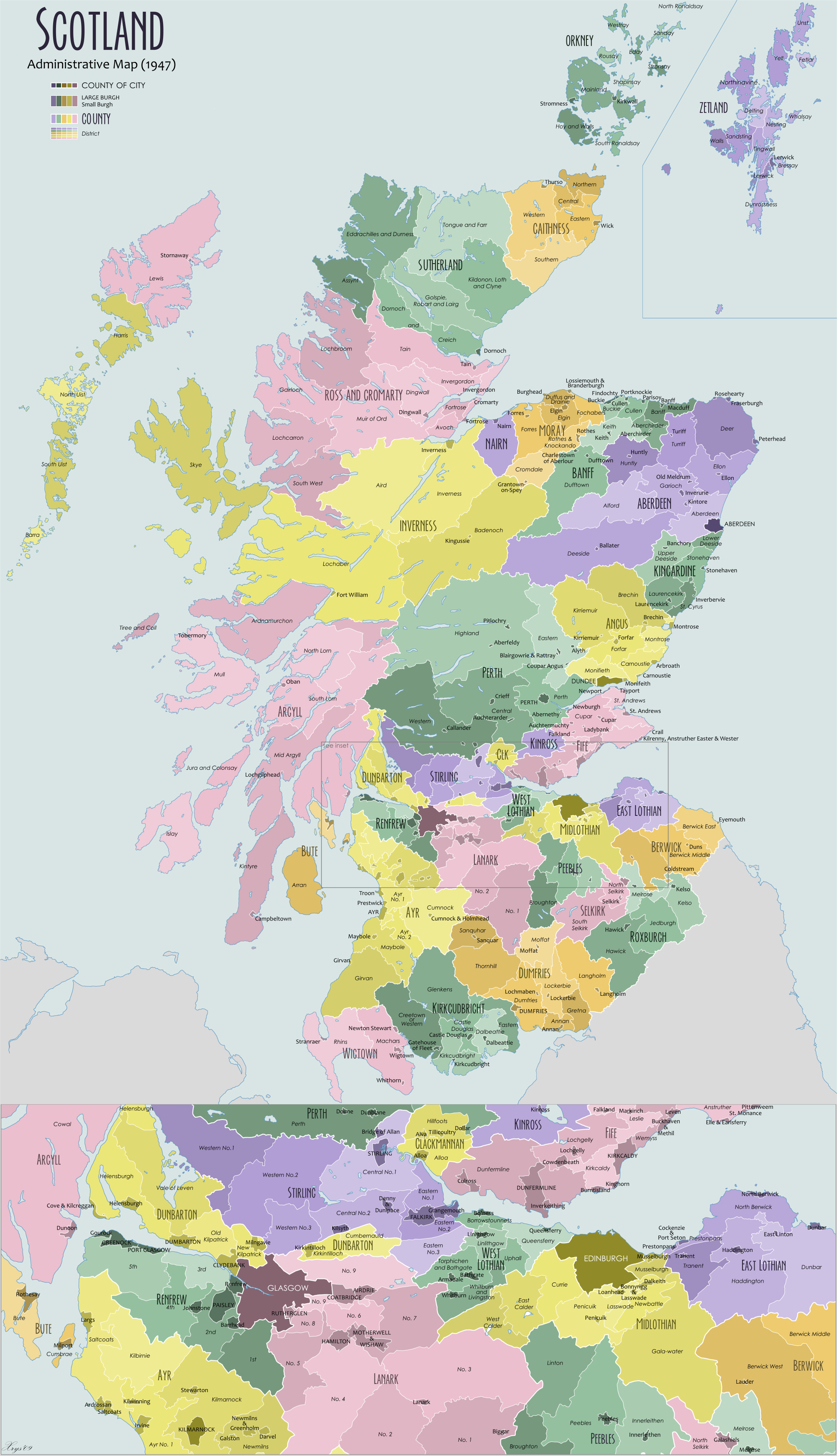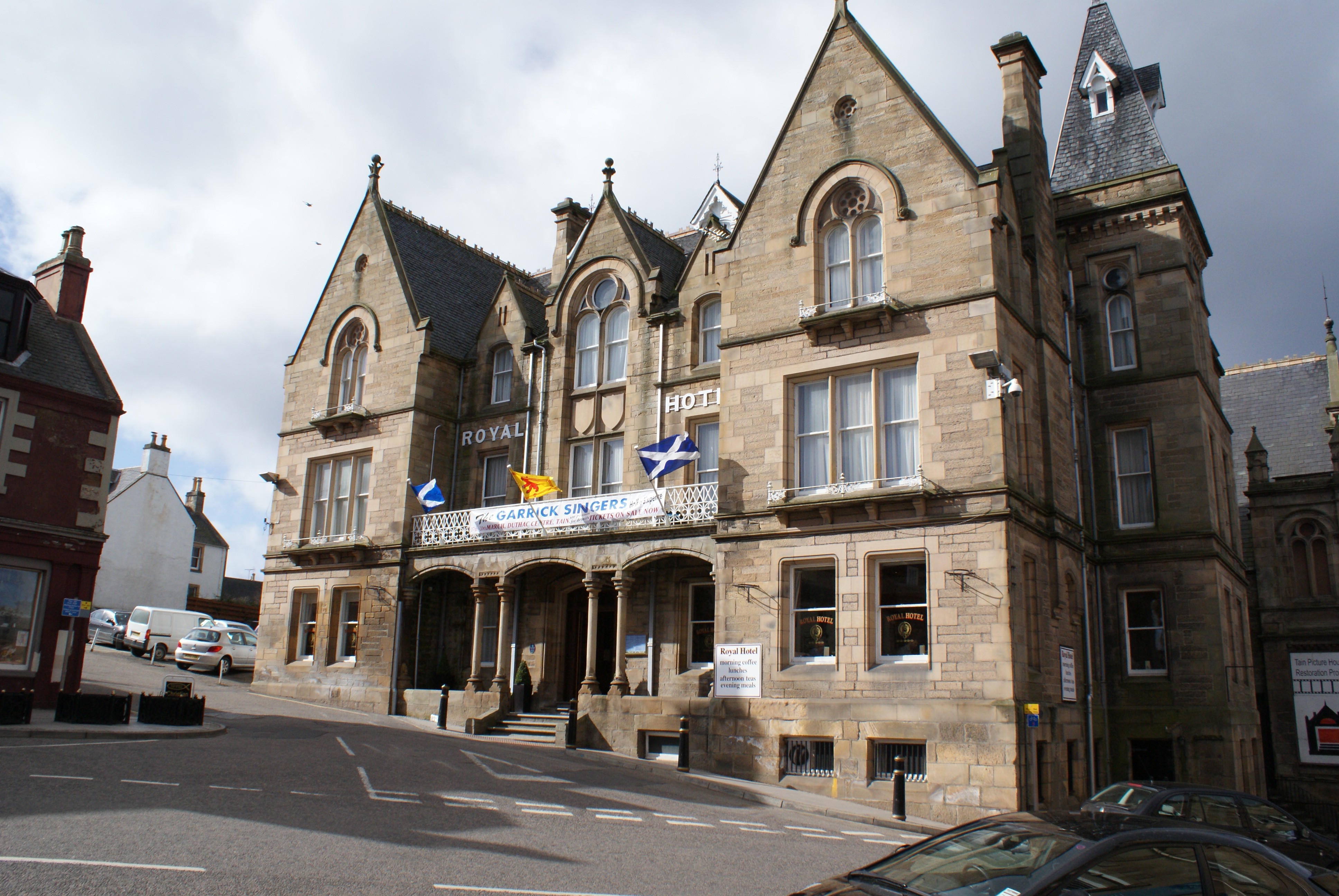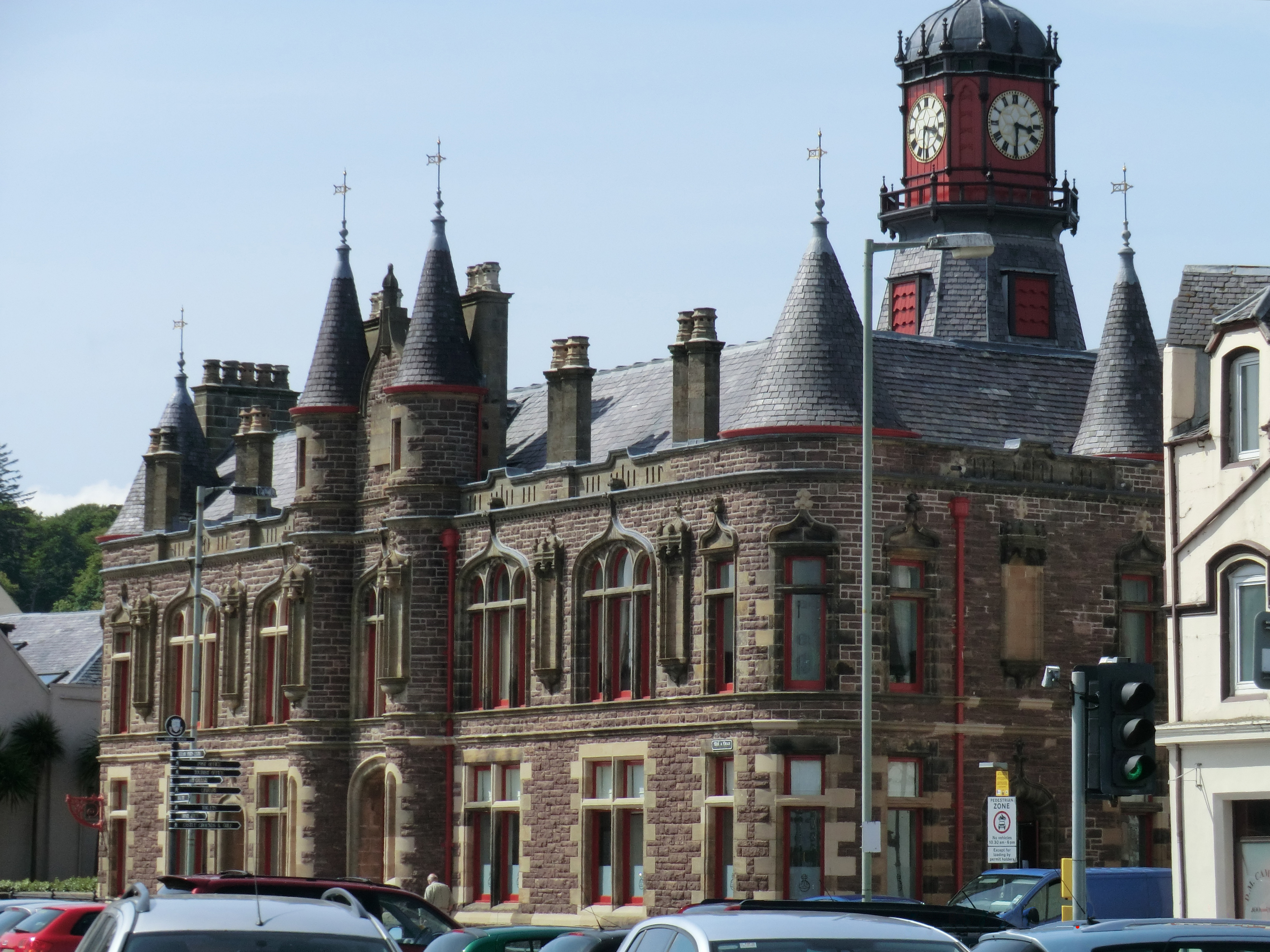|
Ross And Cromarty
Ross and Cromarty (), is an area in the Highlands and Islands of Scotland. In modern usage, it is a registration county and a Lieutenancy areas of Scotland, lieutenancy area. Between 1889 and 1975 it was a Shires of Scotland, county. Historically, Ross-shire and Cromartyshire were separate counties, with Cromartyshire comprising a number of disconnected tracts of land scattered across Ross-shire. The two counties shared a Sheriff of Ross and Cromarty, sheriff from 1748, and were both included in the Ross and Cromarty (UK Parliament constituency), Ross and Cromarty constituency from 1832. They were formally united into a single county called Ross and Cromarty in 1889. The mainland part of the county had a coast to the east onto the Moray Firth, and a coast to the west onto the Minch. Much of the mainland is sparsely populated, including parts of the Northwest Highlands mountains. The mainland's principal towns are all on the east coast, including Dingwall (the county town), Alnes ... [...More Info...] [...Related Items...] OR: [Wikipedia] [Google] [Baidu] |
Shires Of Scotland
The counties or shires of Scotland () were historic subdivisions of Scotland. The shires were originally established in the Middle Ages for judicial purposes, being territories over which a Sheriff principal, sheriff had jurisdiction. They were distinct from the various older mormaerdoms, earldoms and other territories into which Scotland was also divided, which are collectively termed the provinces of Scotland by modern historians. The provinces gradually lost their functions, whereas the shires gradually gained functions. From the 16th century, the shires served as county constituency, constituencies, electing shire commissioners to the Parliament of Scotland. From 1667 each shire had Commissioners of Supply, commissioners of supply responsible for collecting local taxes; the commissioners of supply were subsequently given various local government functions as well. From 1797, the shires also served as areas for organising the militia, which was the responsibility of a lord-li ... [...More Info...] [...Related Items...] OR: [Wikipedia] [Google] [Baidu] |
Tain
Tain ( ) is a royal burgh and parish in the County of Ross, in the Scottish Highlands, Highlands of Scotland. Etymology The name derives from the nearby River Tain, the name of which comes from an Indo-European root meaning 'flow'. The Gaelic name, ''Baile Dubhthaich'', means 'Duthac's town', after a local saint also known as Saint Duthac, Duthus. History Tain was granted its first royal charter in 1066, making it Scotland's oldest royal burgh, commemorated in 1966 with the opening of the Rose Garden by Elizabeth Bowes-Lyon, Queen Elizabeth, the Queen Mother. The 1066 charter, granted by King Malcolm III of Scotland, Malcolm III, confirmed Tain as a sanctuary, where people could claim the protection of the church, and an immunity, in which resident merchants and traders were exempt from certain taxes. Little is known of earlier history although the town owed much of its importance to Duthac. He was an early Christian figure, perhaps 8th or 9th century, whose shrine had become s ... [...More Info...] [...Related Items...] OR: [Wikipedia] [Google] [Baidu] |
Skye And Lochalsh
Skye and Lochalsh () was a local government district, created in 1975 as one of eight districts within the Highland region in Scotland. It include the Isle of Skye and the Lochalsh area on the mainland. The main offices of the council were in Portree, on the Isle of Skye. The district was abolished in 1996 when Highland was made a single-tier council area. History The district was created in 1975 under the Local Government (Scotland) Act 1973, which abolished Scotland's counties, burghs and landward districts and replaced them with a two-tier system of regions and districts. The new district covered two former districts: the Skye district from Inverness-shire (covering the Isle of Skye and neighbouring Inner Hebridean islands) and the South West district from Ross and Cromarty (covering the parishes of Lochalsh, Kintail and Glenshiel). Skye and Lochalsh District Council was a district-level authority, with regional-level functions provided by the Highland Regional Council ... [...More Info...] [...Related Items...] OR: [Wikipedia] [Google] [Baidu] |
Districts Of Scotland
A district is a type of administrative division that in some countries is managed by the local government. Across the world, areas known as "districts" vary greatly in size, spanning regions or county, counties, several municipality, municipalities, subdivisions of municipalities, school district, or political district. Etymology The word "district" in English is a Loanword, loan word from French language, French. It comes from Medieval Latin districtus–"exercising of justice, restraining of offenders". The earliest known English-language usage dates to 1611, in the work of lexicographer Randle Cotgrave. By country or territory Afghanistan In Afghanistan, a district (Persian language, Persian ) is a subdivision of a province. There are almost 400 districts in the country. Australia Electoral districts are used in state elections. Districts were also used in several states as cadastral units for land titles. Some were used as squatting districts. Cadastral divi ... [...More Info...] [...Related Items...] OR: [Wikipedia] [Google] [Baidu] |
Na H-Eileanan An Iar
The Outer Hebrides ( ) or Western Isles ( , or ), sometimes known as the Long Isle or Long Island (), is an island chain off the west coast of mainland Scotland. It is the longest archipelago in the British Isles. The islands form part of the archipelago of the Hebrides, separated from the Scottish mainland and from the Inner Hebrides by the waters of the Minch, the Little Minch, and the Sea of the Hebrides. The Outer Hebrides are considered to be the traditional heartland of the Gaelic language. The islands form one of the 32 council areas of Scotland, which since 1998 has used only the Gaelic form of its name, including in English language contexts. The council area is called Na h-Eileanan an Iar ('the Western Isles') and its council is ('Council of the Western Isles'). Most of the islands have a bedrock formed from ancient metamorphic rocks, and the climate is mild and oceanic. The 15 inhabited islands had a total population of in and there are more than 50 substa ... [...More Info...] [...Related Items...] OR: [Wikipedia] [Google] [Baidu] |
Scots Gaelic
Scottish Gaelic (, ; endonym: ), also known as Scots Gaelic or simply Gaelic, is a Celtic language native to the Gaels of Scotland. As a member of the Goidelic branch of Celtic, Scottish Gaelic, alongside both Irish and Manx, developed out of Old Irish. It became a distinct spoken language sometime in the 13th century in the Middle Irish period, although a common literary language was shared by the Gaels of both Ireland and Scotland until well into the 17th century. Most of modern Scotland was once Gaelic-speaking, as evidenced especially by Gaelic-language place names. In the 2011 census of Scotland, 57,375 people (1.1% of the Scottish population, three years and older) reported being able to speak Gaelic, 1,275 fewer than in 2001. The highest percentages of Gaelic speakers were in the Outer Hebrides. Nevertheless, there is a language revival, and the number of speakers of the language under age 20 did not decrease between the 2001 and 2011 censuses. In the 2022 census ... [...More Info...] [...Related Items...] OR: [Wikipedia] [Google] [Baidu] |
Western Isles
The Outer Hebrides ( ) or Western Isles ( , or ), sometimes known as the Long Isle or Long Island (), is an island chain off the west coast of mainland Scotland. It is the longest archipelago in the British Isles. The islands form part of the archipelago of the Hebrides, separated from the Scottish mainland and from the Inner Hebrides by the waters of the Minch, the Little Minch, and the Sea of the Hebrides. The Outer Hebrides are considered to be the traditional heartland of the Gaelic language. The islands form one of the 32 council areas of Scotland, which since 1998 has used only the Gaelic form of its name, including in English language contexts. The council area is called Na h-Eileanan an Iar ('the Western Isles') and its council is ('Council of the Western Isles'). Most of the islands have a bedrock formed from ancient metamorphic rocks, and the climate is mild and oceanic. The 15 inhabited islands had a total population of in and there are more than 50 ... [...More Info...] [...Related Items...] OR: [Wikipedia] [Google] [Baidu] |
Council Areas Of Scotland
For local government purposes, Scotland is divided into 32 areas designated as "council areas" (), which are all governed by single-tier authorities designated as "councils". They have the option under the Local Government (Gaelic Names) (Scotland) Act 1997 of being known (but not re-designated) as a "''comhairle''" when opting for a Gaelic name; only ''Comhairle nan Eilean Siar'' (Council of the Western Isles) has chosen this option, whereas the Highland Council (''Comhairle na Gàidhealtachd'') has adopted its Gaelic form alongside its English equivalent, informally. The council areas have been in existence since 1 April 1996, under the provisions of the Local Government etc. (Scotland) Act 1994. Historically, Scotland was divided into 34 counties or shires. Although these no longer have any administrative function, they are still used to some extent in Scotland for cultural and geographical purposes, and some of the current council areas are named after them. There are ... [...More Info...] [...Related Items...] OR: [Wikipedia] [Google] [Baidu] |
Highland (council Area)
Highland (, ; ) is a council areas of Scotland, council area in the Scottish Highlands and is the largest local government area in both Scotland and the United Kingdom. It was the 7th most populous council area in Scotland at the United Kingdom Census 2011, 2011 census. It has land borders with the council areas of Aberdeenshire, Argyll and Bute, Moray and Perth and Kinross. The wider upland area of the Scottish Highlands after which the council area is named extends beyond the Highland council area into all the neighbouring council areas plus Angus, Scotland, Angus and Stirling (council area), Stirling. The Highland Council is based in Inverness, the area's largest settlement. The area is generally sparsely populated, with much of the inland area being mountainous with numerous lochs. The area includes Ben Nevis, the highest mountain in the British Isles. Most of the area's towns lie close to the eastern coasts. Off the west coast of the mainland the council area includes some ... [...More Info...] [...Related Items...] OR: [Wikipedia] [Google] [Baidu] |
Inverness-shire
Inverness-shire () or the County of Inverness, is a Counties of Scotland, historic county in Scotland. It is named after Inverness, its largest settlement, which was also the county town. Covering much of the Scottish Highlands, Highlands and some of the Hebrides, it is Scotland's largest county by land area. It is generally rural and sparsely populated, containing only three towns which held burgh status, being Inverness, Fort William, Scotland, Fort William and Kingussie. The county is crossed by the Great Glen, which contains Loch Ness and separates the Grampian Mountains to the south-east from the Northwest Highlands. The county also includes Ben Nevis, the highest mountain in both Scotland and the United Kingdom. The county ceased to be used for local government purposes in 1975. Since then, the parts of the county on the mainland and in the Inner Hebrides have been part of the Highland (council area), Highland region, which was redesignated a Council areas of Scotland, cou ... [...More Info...] [...Related Items...] OR: [Wikipedia] [Google] [Baidu] |
Sutherland
Sutherland () is a Counties of Scotland, historic county, registration county and lieutenancy areas of Scotland, lieutenancy area in the Scottish Highlands, Highlands of Scotland. The name dates from the Scandinavian Scotland, Viking era when the area was ruled by the Jarl of Orkney; although Sutherland includes some of the northernmost land on the island of Great Britain, it was called ' ("southern land") from the standpoint of Orkney and Caithness. From the 13th century, Sutherland was a provincial lordship, being an earldom controlled by the Earl of Sutherland. The earldom just covered the south-eastern part of the later county. A Shires of Scotland, shire called Sutherland was created in 1633, covering the earldom of Sutherland and the neighbouring provinces of Assynt to the west and Strathnaver to the north. Shires gradually eclipsed the old provinces in administrative importance, and also become known as counties. The county is generally rural and sparsely populated. Suth ... [...More Info...] [...Related Items...] OR: [Wikipedia] [Google] [Baidu] |
Stornoway
Stornoway (; ) is the main town, and by far the largest, of the Outer Hebrides (or Western Isles), and the capital of Lewis and Harris in Scotland. The town's population is around 6,953, making it the third-largest island town in Scotland after Kirkwall in Orkney and Lerwick in Shetland. The historical civil parish of Stornoway, which includes various nearby villages, has a combined population of just over 10,000. The Comhairle nan Eilean Siar (the Western Isles Council) measures population in a different area: the ''Stornoway settlement'' area, Laxdale, Sandwick and Newmarket; in 2019, the estimated population for this area was 6,953. Stornoway is an important port and the administrative centre of the Outer Hebrides. It is home to Comhairle nan Eilean Siar and a variety of educational, sporting and media establishments. Until relatively recently, observance of the Christian Sabbath (Sunday) has been associated with Hebridean culture. Recent changes mean that Sund ... [...More Info...] [...Related Items...] OR: [Wikipedia] [Google] [Baidu] |










